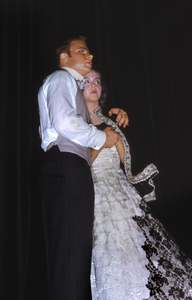
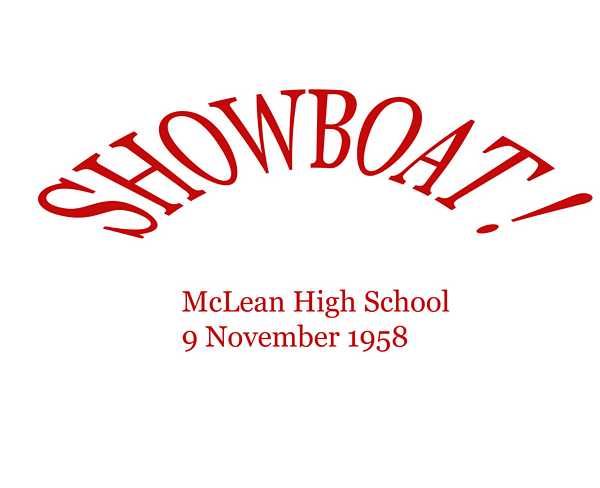
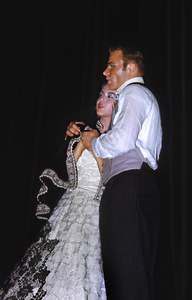
bottom & links
Wes
Sanders '59
and
Mary Lena Patterson '59 in Jerome Kern and Oscar Hammerstein II's
adaptation of the Edna Ferber novel. If
the layout
is jumbled, pull your browser
window open wider to make room. Click any
photo to
enlarge.
Anne
Knodel
'60. We need an address for this lady -- is anyone in
touch? (Contact info for Jerry is on the first
page;
you
can use your "back" button to return.)
Ellen Krueger '60 and Bob Duncan '60 (d. 1975) on the right.
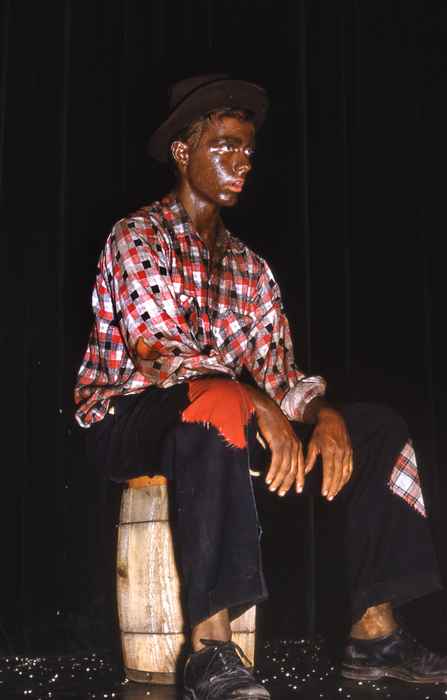 Paul Achenback '59
Paul Achenback '59
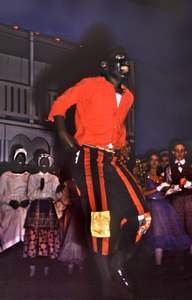
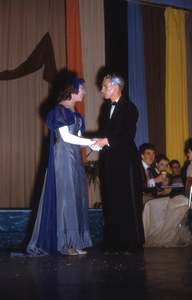
End photos of Showboat. Sorry about the flash -- I managed
other
shows in available light -- much more natural.
The History of Show Boat
In 1925, Edna Ferber spent several weeks on the James Adams Floating
Palace Theater in Bath, North Carolina, gathering information for a
novel about a disappearing American phenomenon: the River Show Boat.
Her best-selling "Show Boat" was published in 1926.
Show Boat is the story of three generations of the Hawks family on the
River Boat, The Cotton Blossom. It follows the fortunes of
Magnolia Hawks and her gambling husband Gaylord
Ravenal.
Magnolia, or "Noli," struggles throughout the story with her
relationship to the Cotton Blossom, owned by her parents, Captain Andy
Hawks and his wife, Parthy. Interwoven into the story of the Hawks and
the Ravenals is the story of the black workers and stevedores along the
Mississippi and on the Cotton Blossom. Queenie and Joe figure
significantly in the lives of the family, and are also part of a
sub-plot on the plight of African-American workers in the Post-Civil
War South. Julie La Verne is a racially mixed performer on the Cotton
Blossom whose husband, Steve, is white. The couple is banned from the
floating theater by a strictly enforced local law against miscegenation.
In the second act of the book, Noli and Ravenal separate, and she
leaves the familiar stage of the River Boat and the waters of the
Mississippi for Chicago, and a future as a musical comedy star.
Magnolia and Ravenal's daughter, Kim Ravenal, follows in her mothers
footsteps as an actress and performer. The second act climaxes in the
reunion of Magnolia and Gay as they watch their daughter, who has
achieved international stardom, perform as they had years before. The
entire plot of the novel and the book is tied together by the dominant
image of the Mississippi River. Ferber's motif is beautiful: the
characters in the story float through their lives, moving through both
peaceful and turbulent times, much as the Cotton Blossom navigates the
unpredictable waters of the Mississippi.
Jerome Kern and Oscar Hammerstein II created the original Broadway
show, produced by Florenz Ziegfield. It opened December 27,
1927
-- an immediate success.
The next production of Edna Ferber's Show Boat was the original
Hollywood version of1936. Director James Whale brought the activities
on the Cotton Blossom to life with many of the same faces from the
Broadway original. Helen Morgan, Charles Winninger and Paul Robeson all
brought their Broadway roles to the screen.
A second Hollywood adaptation, directed by George Sidney, was released
in 1951 This reproduction had a distinct Hollywood flavor,
and
had lost some of the charming innocence of the both the original
Broadway and the original Hollywood versions. The motion picture,
however, was again a tremendous success, and
the cast recording of the music not only sold well, but also
further solidified the place of Show Boat's score in the history of
musical film and musical theater.
The most recent adaptation of the original production was Hal Prince's
1994 revival.
Edited. Original source and more info here.
This
appears to
be from a 1996 Final Project of student Gerard Saviola at UVa,
but
all credit and reference to the student has been removed from the Web
materials. Tut, tut.
Show
Boat
changed the course of theater, redirecting the emphasis from the heavy
operettas and the superficial music comedies which had dominated
Broadway. Characters were far more three-dimensional, the integration
of music and plot was far more skillfully maneuvered. More
important, Kern and Hammerstein had the courage to focus on
more
complex and socially unconventional topics. Show Boat investigates race
relations, miscegenation, and unhappy marriages while remaining
entertaining and musically beautiful. This balance is an eternal legacy
of the original production.
--Alan B.
Howard
(edited), Gerard Saviola's professor.
--end ShowBoat
Home page for
McLean60 -- Webpages list
top
rev 10/05
3/2011





